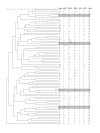Short tandem repeat sequences in the Mycoplasma genitalium genome and their use in a multilocus genotyping system
- PMID: 18664269
- PMCID: PMC2515158
- DOI: 10.1186/1471-2180-8-130
Short tandem repeat sequences in the Mycoplasma genitalium genome and their use in a multilocus genotyping system
Abstract
Background: Several methods have been reported for strain typing of Mycoplasma genitalium. The value of these methods has never been comparatively assessed. The aims of this study were: 1) to identify new potential genetic markers based on an analysis of short tandem repeat (STR) sequences in the published M. genitalium genome sequence; 2) to apply previously and newly identified markers to a panel of clinical strains in order to determine the optimal combination for an efficient multi-locus genotyping system; 3) to further confirm sexual transmission of M. genitalium using the newly developed system.
Results: We performed a comprehensive analysis of STRs in the genome of the M. genitalium type strain G37 and identified 18 loci containing STRs. In addition to one previously studied locus, MG309, we chose two others, MG307 and MG338, for further study. Based on an analysis of 74 unrelated patient specimens from New Orleans and Scandinavia, the discriminatory indices (DIs) for these three markers were 0.9153, 0.7381 and 0.8730, respectively. Two other previously described markers, including single nucleotide polymorphisms (SNPs) in the rRNA genes (rRNA-SNPs) and SNPs in the MG191 gene (MG191-SNPs) were found to have DIs of 0.5820 and 0.9392, respectively. A combination of MG309-STRs and MG191-SNPs yielded almost perfect discrimination (DI = 0.9894). An additional finding was that the rRNA-SNPs distribution pattern differed significantly between Scandinavia and New Orleans. Finally we applied multi-locus typing to further confirm sexual transmission using specimens from 74 unrelated patients and 31 concurrently infected couples. Analysis of multi-locus genotype profiles using the five variable loci described above revealed 27 of the couples had concordant genotype profiles compared to only four examples of concordance among the 74 unrelated randomly selected patients.
Conclusion: We propose that a combination of the MG309-STRs and MG191-SNPs is efficient for general epidemiological studies and addition of MG307-STRs and MG338-STRs is potentially useful for sexual network studies of M. genitalium infection. The multi-locus typing analysis of 74 unrelated M. genitalium-infected individuals and 31 infected couples adds to the evidence that M. genitalium is sexually transmitted.
Figures





References
Publication types
MeSH terms
Substances
Associated data
- Actions
- Actions
- Actions
- Actions
- Actions
- Actions
- Actions
- Actions
- Actions
- Actions
Grants and funding
LinkOut - more resources
Full Text Sources

